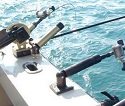 Chinook and coho salmon, brown and rainbow trout part of annual stocking plans. After stocking more than 2.6 million fish into the Wisconsin waters of Lake Michigan in 2015, the Department of Natural Resources is relying on recent harvest data and survey research to implement its Lake Michigan stocking plans for the coming year.
Chinook and coho salmon, brown and rainbow trout part of annual stocking plans. After stocking more than 2.6 million fish into the Wisconsin waters of Lake Michigan in 2015, the Department of Natural Resources is relying on recent harvest data and survey research to implement its Lake Michigan stocking plans for the coming year.
At the same time, the department is employing a variety of techniques and monitoring efforts to ensure that stocked fish have the greatest chance for survival given the challenging predator to prey ratio in Lake Michigan. Brad Eggold, DNR southern Lake Michigan fisheries supervisor, said the department’s stocking efforts are part of a strategy that complements natural reproduction in the lake and its tributaries to provide diverse angling opportunities.
“We are committed to sustaining and improving the world-class fishery in Lake Michigan while recognizing that the makeup of the fishery may change over time,” Eggold said. “Based on the best available science and our own management experience, we stock strategically to optimize returns while taking advantage of natural reproduction to maximize efficiency. We also work closely with partners in our neighboring states and the federal government to manage the resource in a coordinated way. “
Overall, 2016 Wisconsin stocking numbers are expected to total 2.3 million chinook and coho salmon as well as brown and rainbow trout. Chinook salmon will again represent the greatest number of fish stocked into the Wisconsin waters of Lake Michigan as plans call for the release of approximately 808,254 chinook, down from 823,496 for 2015.
In 2013, chinook salmon stocking was reduced by 30 percent because of concerns over declining alewife populations. This year’s stocking plan continues to reflect those concerns as recent survey data indicates record low levels of alewives and other forage fish due to predation and invasive quagga mussels removing nutrients from the water.
Estimates by the U.S. Fish and Wildlife Service indicate that natural reproduction currently accounts for more than 60 percent of all chinook in Lake Michigan and the stocking plans by Wisconsin and other states attempt to factor in the impact of these wild fish.
Eggold said the above-average survival rate of chinook stocked by Wisconsin means anglers here benefit both from stocked and naturally produced fish that spend a significant amount of time feeding along the lake’s western shore during the summer and from the stocked fish that return to spawn in the fall. DNR continues to review its chinook stocking distribution and is working with stakeholder groups using net pens in five locations and a subset of those to study whether this rearing and release technique improves fish growth and returns.
While chinook account for the single largest number of fish introduced each year, DNR’s efforts to stock hundreds of thousands of coho salmon, brown trout and rainbow trout at more than 40 locations along the Lake Michigan coast support diverse angling opportunities, said Dave Giehtbrock, DNR fisheries culture section chief.
“Rearing and stocking salmon and trout are among our most important management activities,” Giehtbrock said. “We appreciate stakeholder interest in our propagation efforts as well as the public and private support we’ve received to improve our hatchery facilities.”
For 2016, the department intends to stock 676,637 brown trout (820,954 in 2015), 460,094 coho (539,129 in 2015) and 390,004 rainbow trout (432,665 in 2015). Additionally, some 12,500 Great Lakes spotted musky are being produced and 3,500 lake sturgeon are being reared as part of a reintroduction project in the Milwaukee and Kewaunee Rivers. Actual stocking numbers may vary based on production.
In 2016, the Wisconsin waters of Lake Michigan should also receive about 800,000 lake trout produced by U.S. Fish and Wildlife Service.
To learn more about Lake Michigan fisheries management including historic stocking trends visit the DNR website, dnr.wi.gov, and search “Fishing Lake Michigan.”
Contact(s): Brad Eggold, DNR southern Lake Michigan Fisheries supervisor, 414-382-7921, Bradley.Eggold@wisconsin.gov
